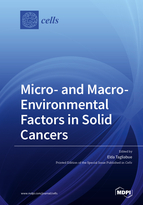Micro- and Macro-Environmental Factors in Solid Cancers
A special issue of Cells (ISSN 2073-4409).
Deadline for manuscript submissions: closed (15 February 2023) | Viewed by 20939
Special Issue Editor
Interests: HER2-positive breast cancer; triple-negative breast cancer; tumor microenvironment
Special Issues, Collections and Topics in MDPI journals
Special Issue Information
Dear Colleagues,
Although cancer development and progression depend on stochastic mutational events, active cross-talk between cancer cells and the normal cells surrounding them is essential in supporting tumor progression.
Cells adjacent to tumors rapidly acquire characteristics that render them able to sustain tumor progression and resistance to treatment. Cancer-associated fibroblasts take part in tumorigenesis by creating an environment permissive to tumor proliferation and invasiveness. Similarly, in several different solid cancers, adipocytes modify their phenotype to decrease the expression of differentiation markers and lipid content and participate in the acquisition of an aggressive tumor phenotype.
The formation of new blood vessels, which is essential to supply oxygen and nutrients to the tumor and to provide a gateway for metastasis, is regulated by the balance between angiogenic activators and inhibitors within the tumor microenvironment.
During tumor progression, tumor cell variants resulting from immune selection promote a pro-tumor immune milieu other than facilitating the escape from immune attack.
Besides an abnormal organ composed of multiple cell types, which contributes to its malignancy, the tumor has to be seen in the context of the host environment. The development and progression of malignant cells are strictly dependent on reprogramming of the cellular metabolism to fulfill the biosynthetic demands associated with proliferation. Host metabolic and gut microbiota characteristics regulate energy storage and inflammation levels and are in turn dependent on lifestyle.
Understanding the micro- and macro-environmental factors that support solid tumors is at the root of cancer prevention and cure.
In this Special Issue of Cells, we invite your contributions, either in the form of original research articles, reviews, or shorter perspective articles on all aspects related to the theme of “Micro- and macro-environmental factors in solid cancers.
Relevant topics include, but are not limited to
- Cancer-associeted fibroblasts: their characteristics, function and interplay with tumors
- Cancer-associeted adipocytes: their characteristics, function and interplay with tumors
- Interaction of the extracellular matrix, stoma and tumor cells
- Tumor angiogenesis
- Tumor-infiltrating immune cells: their characteristics, function and interplay with tumors
- Tumor metabolism
- Bi-directional interplay between tumor and host (e.g. obesity, BMI, lifestyle cachexia)
- Commensal bacteria and tumor
Dr. Elda Tagliabue
Guest Editor
Manuscript Submission Information
Manuscripts should be submitted online at www.mdpi.com by registering and logging in to this website. Once you are registered, click here to go to the submission form. Manuscripts can be submitted until the deadline. All submissions that pass pre-check are peer-reviewed. Accepted papers will be published continuously in the journal (as soon as accepted) and will be listed together on the special issue website. Research articles, review articles as well as short communications are invited. For planned papers, a title and short abstract (about 100 words) can be sent to the Editorial Office for announcement on this website.
Submitted manuscripts should not have been published previously, nor be under consideration for publication elsewhere (except conference proceedings papers). All manuscripts are thoroughly refereed through a single-blind peer-review process. A guide for authors and other relevant information for submission of manuscripts is available on the Instructions for Authors page. Cells is an international peer-reviewed open access semimonthly journal published by MDPI.
Please visit the Instructions for Authors page before submitting a manuscript. The Article Processing Charge (APC) for publication in this open access journal is 2700 CHF (Swiss Francs). Submitted papers should be well formatted and use good English. Authors may use MDPI's English editing service prior to publication or during author revisions.
Keywords
- stromal cells
- immune cells
- angiogenesis
- metabolism
- commensal bacteria
- obesity
- BMI
- lifestyle
- cachexia







